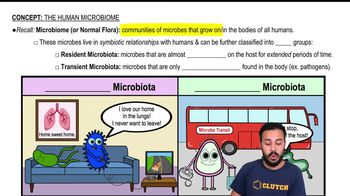Define symbiosis. Differentiate commensalism, mutualism, and parasitism, and give an example of each.
 Tortora 14th Edition
Tortora 14th Edition Ch. 14+15 - Principles of Disease and Epidemiology | Microbial Mechanisms of Pathogenicity
Ch. 14+15 - Principles of Disease and Epidemiology | Microbial Mechanisms of Pathogenicity Problem 14.3a
Problem 14.3aWhich of the following statements is false?
a. E. coli never causes disease.
b. E. coli provides vitamin K for its host.
c. E. coli often exists in a mutualistic relationship with humans.
d. A disease-causing strain of E. coli causes bloody diarrhea.
 Verified step by step guidance
Verified step by step guidance
Verified Solution
Key Concepts
E. coli and Human Health

Mutualism in Microbiology

Pathogenic Strains of E. coli

All members of a group of ornithologists studying barn owls in the wild have had
salmonellosis (Salmonella gastroenteritis). One birder is experiencing her third infection. What is the most likely source of their infections?
a. The ornithologists are eating the same food.
b. They are contaminating their hands while handling the owls and nests.
c. One of the workers is a Salmonella carrier.
d. Their drinking water is contaminated.
Indicate whether each of the following conditions is typical of subacute, chronic, or acute infections.
a. The patient experiences a rapid onset of malaise; symptoms last 5 days.
b. The patient experiences cough and breathing difficulty for months.
c. The patient has no apparent symptoms and is a known carrier.
Among hospital patients who have infections, one-third did not enter the hospital with the infection but rather acquired it in the hospital. How do they acquire these infections? What is the method of transmission of these infections? What is the reservoir of infection?
Which of the following is not one of Koch's postulates?
a. The same pathogen must be present in every case of the disease.
b. The pathogen must be isolated and grown in pure culture from the diseased host.
c. The pathogen from pure culture must cause the disease when inoculated into a healthy, susceptible laboratory animal.
d. The disease must be transmitted from a diseased animal to a healthy, susceptible animal by direct contact.
e. The pathogen must be isolated in pure culture from an experimentally infected lab animal.
Distinguish symptoms from signs as signals of disease.